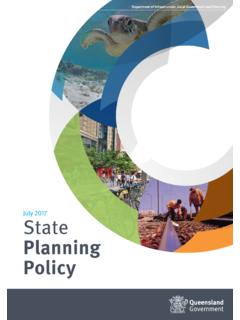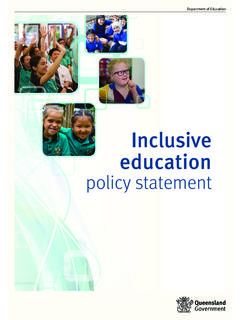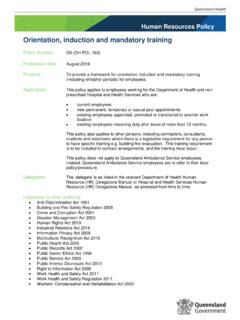Transcription of Inclusive education - ppr.det.qld.gov.au
1 Inclusive education Implementation Date: 25/06/2018. Audience Version: The Inclusive education policy applies department-wide including all state schools and educational settings. Purpose This policy sets out the Department of education 's (the department's) commitment to continue to work towards a more Inclusive state education system and the principles, which will guide that work. policy statement The department commits to continuing our journey towards a more Inclusive education system at policy and regional levels, and as part of our everyday practice in schools, educational settings and classrooms. Inclusive education means that students can access and fully participate in learning, alongside their similar-aged peers, supported by reasonable adjustments and teaching strategies tailored to meet their individual needs. Inclusion is embedded in all aspects of school life, and is supported by culture, policies and every day practices. Inclusive education differs from the following approaches and practices in significant ways: Integration students are placed in schools or educational settings with their similar-aged peers but adjustments are not made to meet their individual needs.
2 This limits their ability to fully access or participate in learning. Integration is not necessarily a step towards inclusion. Segregation students learn in separate environments, designed or used to respond to their particular needs or impairment, in isolation from other students. Exclusion students are unable to access any form of education . The department's commitment to Inclusive education We have high expectations of all students, recognising that, with the right support, all students can succeed. Our commitment means that children and young people across Queensland, from all social, cultural, community and family backgrounds, and of all identities and all abilities can: attend their local state school and education centre and be welcomed Uncontrolled copy. Refer to the Department of education policy and Procedure Register at to ensure you have the most current version of this document. Page 1 of 5. access and participate in a high-quality education and fully engage in the curriculum alongside their similar-aged peers learn in a safe and supportive environment, free from bullying, discrimination or harassment achieve academically and socially with reasonable adjustments and supports tailored to meet their learning needs.
3 The department will continue to offer parents the choice of enrolling their child, who meets set criteria in highly individualised programs, including through special schools and academies. Principles The department's work towards a more Inclusive state education system will be guided by nine principles adapted from the United Nations' nine core features for Inclusive education . A system-wide approach Inclusive education is implemented systemically, based on evidence, across the department including in schools and other educational settings. We promote and develop policies, programs and practices to remove barriers and promote Inclusive education across the department and within local school communities. Committed leaders Leaders, at all levels within the department, across regions and local school communities, commit to and are accountable for implementing Inclusive education . They promote a culture and shared values that remove barriers and support inclusion. Whole of school Every member of the school community, including teachers, support staff, volunteers, families and students, works collaboratively to ensure students can access and participate in all aspects of school life.
4 Curriculum is provided to all students in ways that are age appropriate and responsive to diverse learning needs. Collaboration with students, families and the community We work with students, parents and caregivers, and other organisations, including teacher and professional associations, as respected and valued partners in Inclusive education . We support students, parents, caregivers and families to have a voice and be heard. Their views are considered in decision making at all levels. Respecting and valuing diversity All students and families feel and are welcome, respected, included and safe at our state schools. We embrace and make visible diversity as a strength and support respectful relationships within the school community, and between students. We address the different barriers experienced by students and develop strategies and plans to support Inclusive education for our diverse student population. Confident, skilled and capable workforce Our school leaders, teachers, department staff, support staff and volunteers build on their expertise to implement Inclusive education practices.
5 Good practice, based on evidence, is shared and cultural capability is strengthened. Continuous professional learning and mentorship is encouraged and supported. Uncontrolled copy. Refer to the Department of education policy and Procedure Register at to ensure you have the most current version of this document. Page 2 of 5. Accessible learning environments Our schools, educational settings and classrooms will be designed to enable students of all backgrounds, identities and abilities to access and fully participate in learning. We ensure that students can access and participate in school activities and events. Effective transitions The transition from early childhood and care settings to school, and from school to work, training and higher education are significant milestones in students' lives. Schools continue to work in partnership with students, families, community organisations, professional groups, and other government and educational organisations to plan and support successful transitions at all points in a learner's education .
6 Monitoring and evaluation Monitoring the progress and academic achievement of all students will continue to be a priority. Evaluation and reviews will occur at all levels school, regional and system to ensure the department is continuing on its journey and to build on good practice. Requirements This policy requires the department and all state schools to comply with the education (General Provisions). Act 2006 (Qld) and state and commonwealth discrimination laws. As different student groups experience different barriers to inclusion, the department will continue to implement strategies and policies, and support practices that address the unique needs of: Aboriginal and Torres Strait Islander students students from culturally and linguistically diverse backgrounds students who identify as LGBTIQ. students living in out-of-home care students from rural and remote communities students with disability students with mental health needs gifted and talented students. Definitions Discrimination can be both direct and indirect.
7 Direct discrimination involves treating someone less favourably than another person in similar circumstances because they have a characteristic, for example a disability or impairment, their gender, age, race, Discrimination parental status, sexuality or cultural background. Indirect discrimination occurs when everyone is treated in exactly the same way even though this unreasonably disadvantages someone because they, or their associate, have a characteristic. Uncontrolled copy. Refer to the Department of education policy and Procedure Register at to ensure you have the most current version of this document. Page 3 of 5. Inclusive education means that all students can access and fully participate in learning alongside their similar-aged peers. Teaching and learning strategies are adjusted to Inclusive education meet students' individual needs. Inclusive education encompasses all aspects of school life and is supported by culture, policies, programs and practices. An adjustment is a measure or action taken to assist a student with disability to participate in education on the same basis as other students.
8 An adjustment is reasonable if it achieves this purpose while taking into account the student's learning Reasonable adjustment needs and balancing the interests of all parties affected, including those of the student with disability, the education provider, staff and other students (definition from Disability Standards for education 2005 (Cwlth). Legislation Age Discrimination Act 2004 (Cwlth). Anti-Discrimination Act 1991 (Qld). Australian Human Rights Commission Act 1986 (Cwlth). Disability Discrimination Act 1992 (Cwlth). Disability Standards for education 2005 (Cwlth). education (General Provisions) Act 2006 (Qld). Multicultural Recognition Act 2016 (Qld). Racial Discrimination Act 1975 (Cwlth). Sex Discrimination Act 1984 (Cwlth). Delegations/Authorisations Nil Related policies Advancing education An action plan for education in Queensland Strategic Plan Every student with disability succeeding plan Every Queenslander Succeeding Disability Service Plan Minister's policy : Criteria to decide a person is a person with a disability' for the purpose of enrolment in state special schools Religious instruction Students in out-of-home care policy statement Supporting student health and wellbeing policy statement Statement of expectations for a disciplined school environment Related procedures Allocation of state education Uncontrolled copy.)
9 Refer to the Department of education policy and Procedure Register at to ensure you have the most current version of this document. Page 4 of 5. Enrolment in state primary, secondary and special schools Exemptions from compulsory schooling and compulsory participation Mature age student applications Refusal to enrol Risk to safety or wellbeing Assistance animals in schools Safe, supportive and disciplined school environment Guidelines A whole school approach to support student learning P-12 curriculum, assessment and reporting framework Curriculum provision to gifted and talented students Curriculum provision to students with disability English as an additional language or dialect (EAL/D) learners Global schools through languages supporting plan Parent and community engagement framework Student learning and wellbeing framework Supporting information/websites Inclusive education Diversity in Queensland schools Information for principals All Abilities Queensland: opportunities for all Contact For further information, please contact: State Schools Disability and Inclusion Branch Email: Review date 30 June 2021.
10 Superseded versions Inclusive education Creative Commons Licence Uncontrolled copy. Refer to the Department of education policy and Procedure Register at to ensure you have the most current version of this document. Page 5 of 5.




